Cell Harvesting Market Size
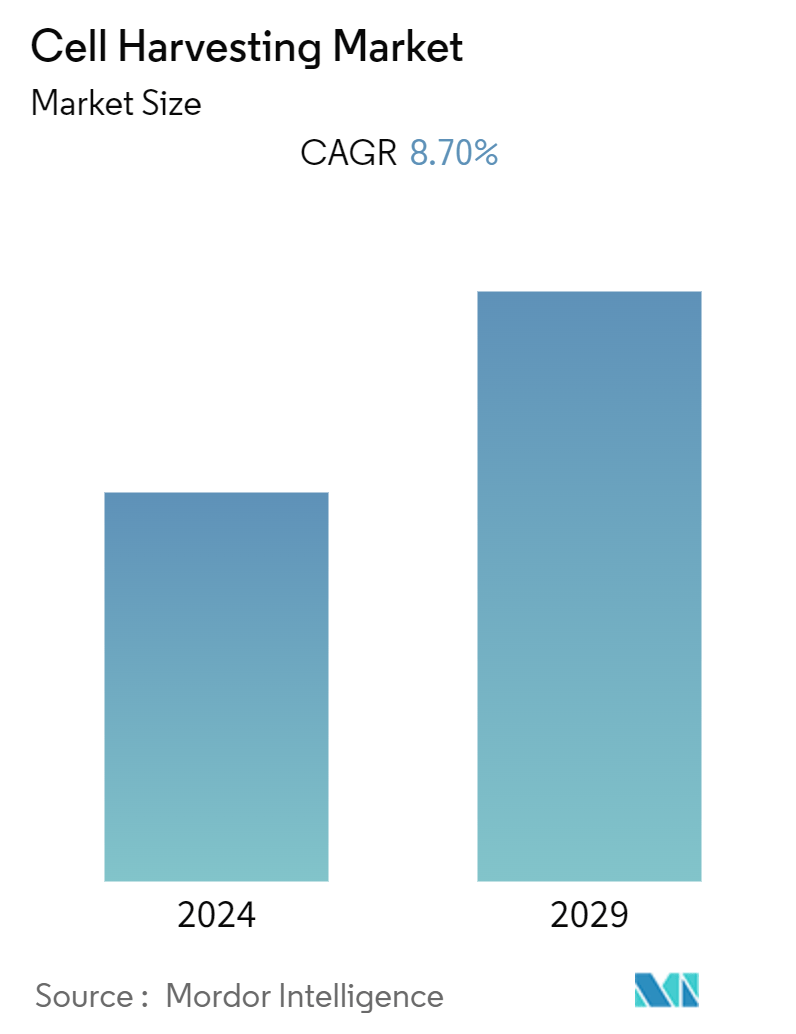
| Study Period | 2019 - 2029 |
| Base Year For Estimation | 2023 |
| CAGR (2024 - 2029) | 8.70 % |
| Fastest Growing Market | Europe |
| Largest Market | North America |
| Market Concentration | High |
Major Players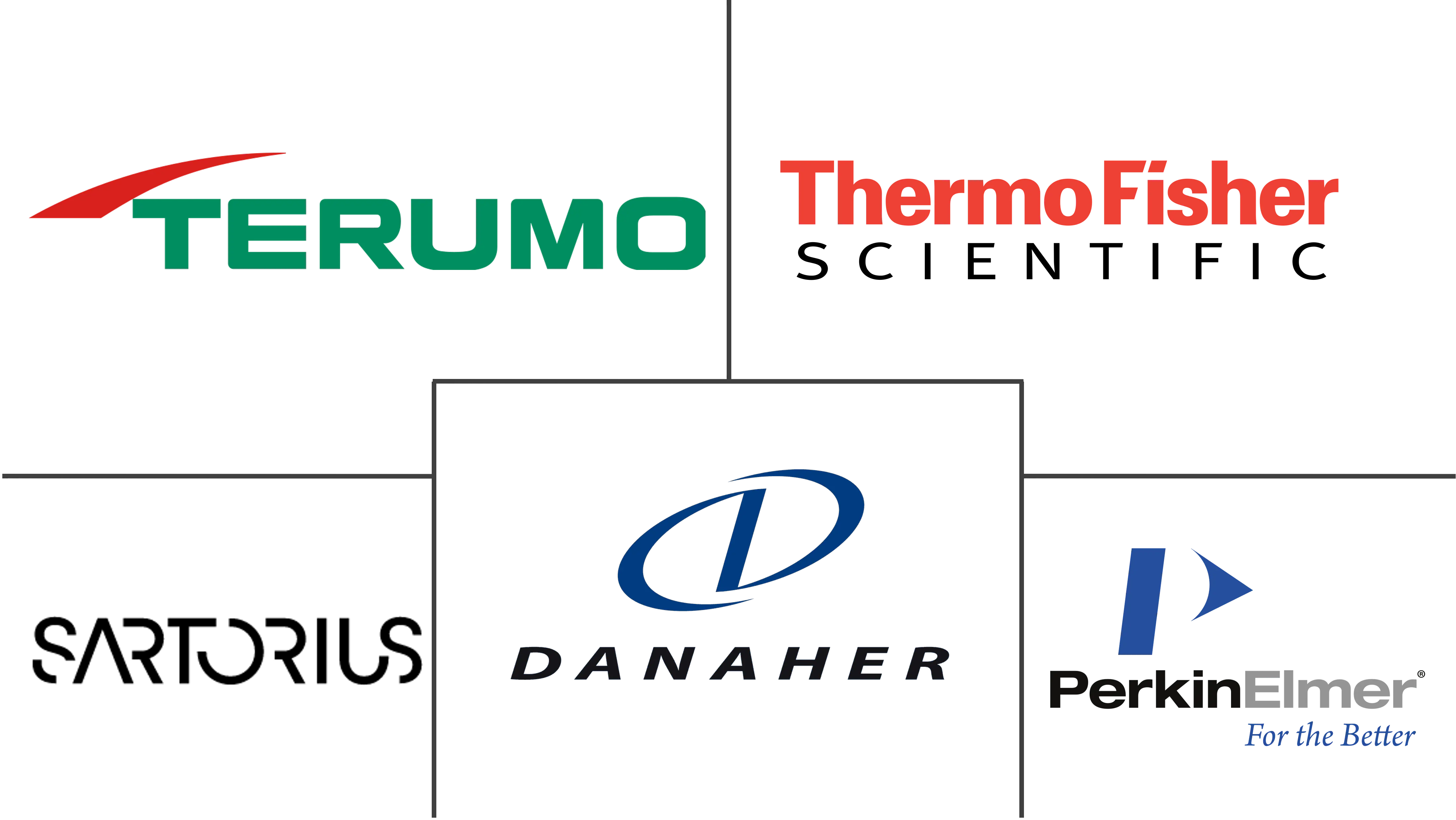
*Disclaimer: Major Players sorted in no particular order |
Cell Harvesting Market Analysis
The Cell Harvesting Market is expected to register a CAGR of 8.70% during the forecast period.
Factors such as rising investments in regenerative medicines and cell-based research are expected to boost market growth. In addition, with the increasing incidence of chronic and infectious diseases and the growing biotechnology and biopharmaceutical industries, the market studied is expected to grow over the forecast period.
Growing government initiatives to accelerate the research and development of regenerative medicine and cell therapy are expected to increase the demand for cell harvesters to reduce the time and cost of cell harvesting. For instance, in February 2022, the Government of India assisted in establishing state-of-the-art stem cell research facilities in 40 premier medical research and educational institutes to promote the study and development of regenerative medicine in the nation. Hence, establishing new research facilities increases the need for cell harvesting equipment, which is anticipated to boost market growth.
Furthermore, the increasing incidence of chronic and infectious diseases among the population raises the need for effective biotechnology-based products or regenerative medicines such as Luxturna and Zolgensma. This is anticipated to boost the demand for cell harvesters, propelling the market’s growth. For instance, as per 2024 statistics published by the Alzheimer's Association, 6.9 million people are living with Alzheimer's in America in 2024, and this number is projected to reach 13.8 million by 2060.
Additionally, according to an article published in BMJ Global Health in March 2022, spinal muscular atrophy (SMA) affects approximately 250-300 newborns in Brazil every year. Thus, the high burden of chronic disease among the population is anticipated to increase the country's focus on developing advanced cell therapy drugs, thereby bolstering market growth.
Moreover, rising product launches by companies increase the availability of advanced cell harvester systems in the market, thereby contributing to the growth of the cell harvesting market. For instance, in June 2022, researchers from the University of Technology Sydney (UTS), in collaboration with Regeneus, a biotech company, developed one of the first 3D-printed microfluidic stem cell harvesting systems. The microfluidic device is designed to collect stem cells from bioreactors, providing an affordable and scalable way to handle stem cells.
Therefore, the market studied is anticipated to grow over the forecast period due to a high burden of chronic diseases, growing biotechnology and biopharmaceutical companies, and rising investments. However, ethical issues about embryonic stem cell research are likely to hinder the growth of the cell harvesting market over the forecast period.
Cell Harvesting Market Trends
The Stem Cell Research Segment Expected to Register a Significant CAGR Over the Forecast Period
The stem cell research segment is anticipated to witness significant growth in the cell harvesting market over the forecast period owing to increasing investments in stem cell research due to its potential in treating several non-curable diseases and growing company activities in the field.
The rising number of stem cell research studies and related funding also contribute to the segment's growth. For instance, according to the data published by the National Institutes of Health (NIH) in May 2024, about USD 835 million was provided by the government for induced pluripotent stem cell research in the United States in 2023. The funds are expected to reach USD 866 million by 2025. This shows growing investments in stem cell research, which are expected to drive the segment's growth over the forecast period.
Furthermore, companies are increasingly focusing on adopting critical strategic initiatives, such as production expansion and product launches, to increase the availability of stem cell-based drugs and therapies in the market. This is also expected to augment the segment's growth over the forecast period. For instance, in March 2024, Gladstone announced plans to expand its capabilities by establishing a center for stem cell disease modeling and CRISPR drug screening with a USD 4 million grant from the California Institute for Regenerative Medicine. Hence, the expansion of stem cell capabilities is likely to raise the demand for cell harvesting equipment, thereby boosting the segment’s growth over the forecast period.
Therefore, the rising number of stem cell research studies and companies’ growing focus on stem cell disease are likely to boost the segment’s growth over the forecast period.
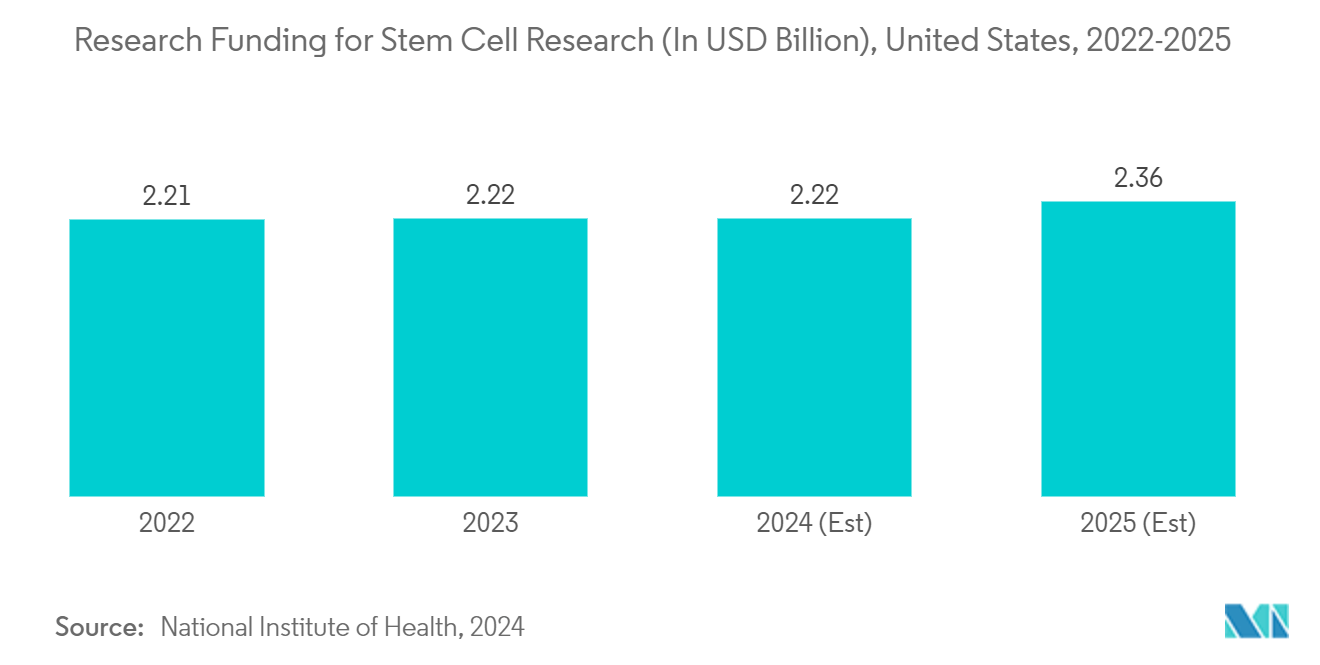
North America Expected to Have a Significant Market Share Over the Forecast Period
North America is expected to occupy a significant share of the cell harvesting market over the forecast period owing to factors such as rising investments in regenerative medicines, the growing biotechnology and biopharmaceutical industries, and the presence of key market players in the region.
In addition, the rising incidence and prevalence of chronic diseases, such as cancer, Alzheimer's disease, and retinal diseases, among the population and growing research into studying the potential of stem cells for treating disease increase the demand for effective treatment therapies and drugs. This is expected to fuel the demand for cell harvesting systems, boosting market growth. For instance, as per the Endocrine Society, in June 2022, a clinical study presented at the Endocrine Society's annual meeting in Atlanta showed that PEC-Direct, an investigational stem cell-based therapy designed to function as a replacement pancreas, has the potential to provide blood sugar control in patients with high-risk type 1 diabetes.
Furthermore, the rising number of companies investing in research and development for developing biotechnology products is expected to increase the biotechnology and biopharmaceutical industry, thereby bolstering market growth. For instance, in November 2022, Orgenesis invested USD 50 million in its subsidiary, Morgenesis, to grow its point-of-care cell therapy platform in the United States. Moreover, the increasing adoption of business strategies, such as collaborations, investments, and acquisitions, is anticipated to increase the availability of regenerative medicines and cell-based products in the market, thus also contributing to the market's growth over the forecast period.
For instance, in October 2022, Meso Numismatics Inc. collaborated with STEM LIFE, which enhances Global Stem Cells Group's goal of establishing its therapies and technology to create centers of excellence in cell therapy to meet the high demand in the Mexican market. Also, in January 2022, ProKidney agreed to a public merger transaction to conduct a pivotal test of its cell therapy with an investment of USD 825 million to support its clinical trial plans.
Therefore, the market studied is anticipated to grow over the forecast period due to the factors above, such as the increasing research studies related to stem cell therapy, growing company activities, and rising research and development investments.
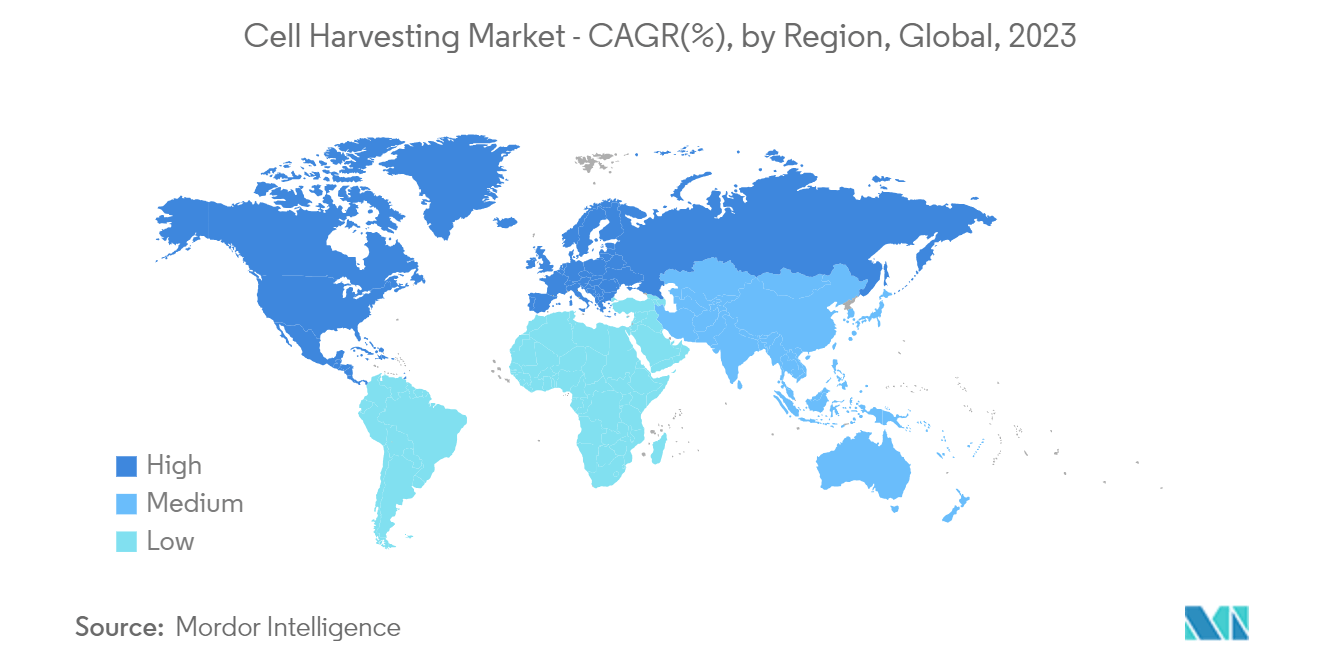
Cell Harvesting Industry Overview
The cell harvesting market is consolidated owing to the presence of a few key players. These companies are expanding their product portfolios by securing new product approvals and launching them globally. Some of the key players in the market are Perkin Elmer Inc., Sartorius AG, Terumo Corporation, Danaher Corporation, Thermo Fisher Scientific, GE Healthcare, and Pall Corporation.
Cell Harvesting Market Leaders
-
Perkin Elmer Inc.
-
Sartorius AG
-
Terumo Corporation
-
Danaher Corporation
-
Thermo Fisher Scientific Inc.
*Disclaimer: Major Players sorted in no particular order
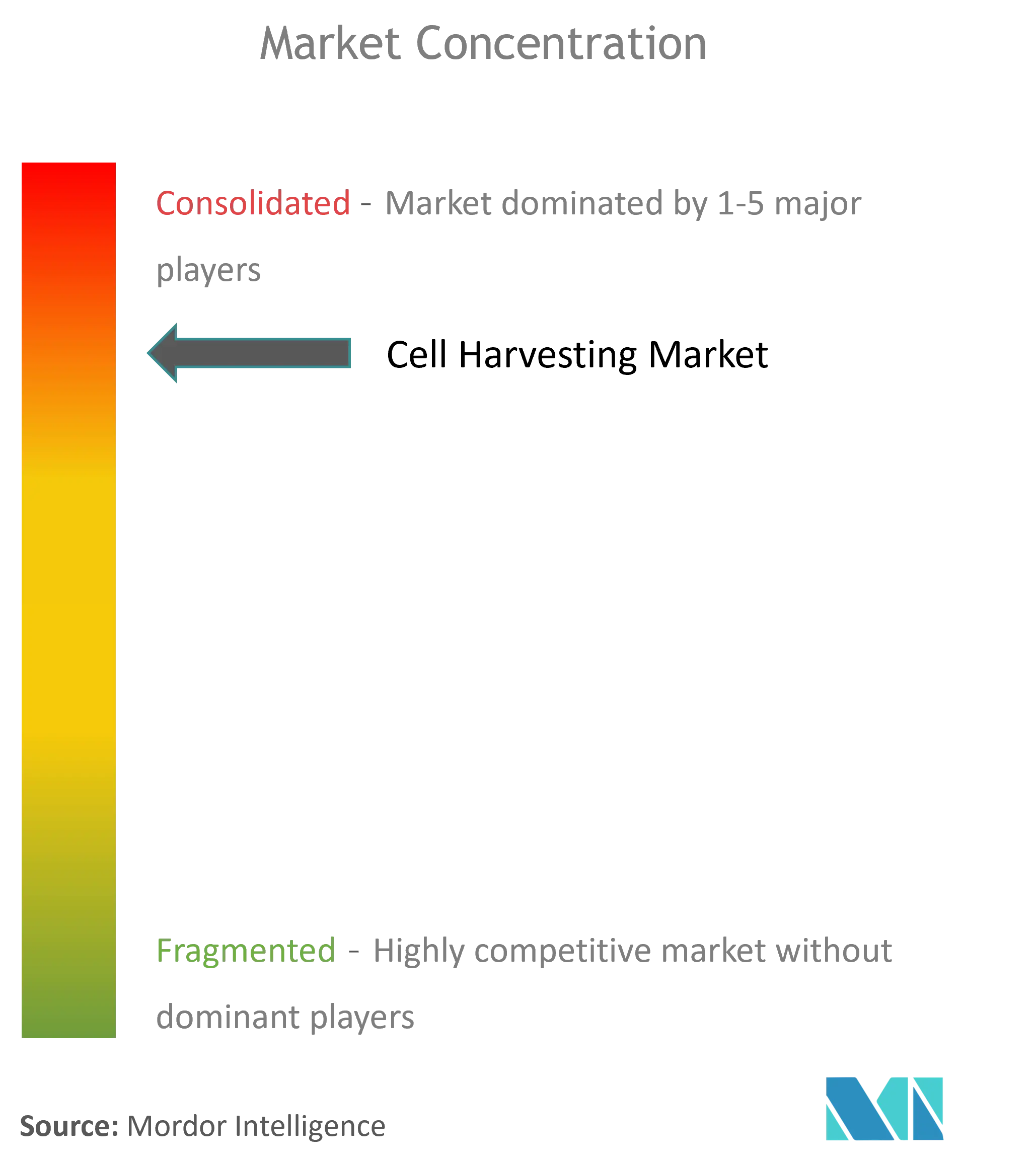
Cell Harvesting Market News
- May 2024: AVITA Medical Inc. received a premarket approval (PMA) supplement from the FDA for its RECELL GO System. This innovative device, leveraging a patient's own skin's regenerative capabilities, is designed to address thermal burn wounds and full-thickness skin defects.
- February 2023: Well Bioscience launched a newly engineered cell harvesting solution, VitroGel Organoid Recovery Solution, which recovers organoids and cells faster and more efficiently.
Cell Harvesting Market Report - Table of Contents
1. INTRODUCTION
- 1.1 Study Assumptions and Market Definition
- 1.2 Scope of the Study
2. RESEARCH METHODOLOGY
3. EXECUTIVE SUMMARY
4. MARKET DYNAMICS
- 4.1 Market Overview
-
4.2 Market Drivers
- 4.2.1 Rising Investments in Regenerative Medicine and Cell-based Research
- 4.2.2 Growth of the Biotechnology and Biopharmaceutical Industries
- 4.2.3 Increasing Incidences of Chronic and Infectious Diseases
-
4.3 Market Restraints
- 4.3.1 Ethical Issues Pertaining to Embryonic Stem Cell Research
-
4.4 Porter's Five Forces Analysis
- 4.4.1 Threat of New Entrants
- 4.4.2 Bargaining Power of Buyers/Consumers
- 4.4.3 Bargaining Power of Suppliers
- 4.4.4 Threat of Substitute Products
- 4.4.5 Intensity of Competitive Rivalry
5. MARKET SEGMENTATION (Market Size by Value - USD)
-
5.1 By Type of Cell Harvesting
- 5.1.1 Manual Cell Harvesters
- 5.1.2 Automated Cell Harvesters
-
5.2 By Application
- 5.2.1 Biopharmaceutical Application
- 5.2.2 Stem Cell Research
- 5.2.3 Other Applications
-
5.3 By End User
- 5.3.1 Biotechnology and Biopharmaceutical Companies
- 5.3.2 Research Institutes
- 5.3.3 Other End Users
-
5.4 Geography
- 5.4.1 North America
- 5.4.1.1 United States
- 5.4.1.2 Canada
- 5.4.1.3 Mexico
- 5.4.2 Europe
- 5.4.2.1 Germany
- 5.4.2.2 United Kingdom
- 5.4.2.3 France
- 5.4.2.4 Italy
- 5.4.2.5 Spain
- 5.4.2.6 Rest of Europe
- 5.4.3 Asia-Pacific
- 5.4.3.1 China
- 5.4.3.2 Japan
- 5.4.3.3 India
- 5.4.3.4 Australia
- 5.4.3.5 South Korea
- 5.4.3.6 Rest of Asia-Pacific
- 5.4.4 Middle East and Africa
- 5.4.4.1 GCC
- 5.4.4.2 South Africa
- 5.4.4.3 Rest of Middle East and Africa
- 5.4.5 South America
- 5.4.5.1 Brazil
- 5.4.5.2 Argentina
- 5.4.5.3 Rest of South America
6. COMPETITIVE LANDSCAPE
-
6.1 Company Profiles
- 6.1.1 Arthrex Inc.
- 6.1.2 AVITA Medical
- 6.1.3 Cox Scientific Ltd
- 6.1.4 Danaher Corporation
- 6.1.5 Perkin Elmer Inc.
- 6.1.6 Sartorius AG
- 6.1.7 Terumo Corporation
- 6.1.8 Tomtec
- 6.1.9 Thermo Fisher Scientific Inc.
- 6.1.10 Esco Lifesciences Group
- 6.1.11 Alcami Corporation
- 6.1.12 Eurofins Scientific
- *List Not Exhaustive
7. MARKET OPPORTUNITIES AND FUTURE TRENDS
** Subject To AvailablityCell Harvesting Industry Segmentation
As per the report's scope, cell harvesting is a technique for collecting different types of cells on the cultural surface. Multiple cell harvesting methods, such as centrifugation, filtration, microfiltration, cell separation, and T-cell culture, are used depending on the types of samples and experiments. Cell harvesting is considered an important operation that involves the removal of cells, cell debris, and other soluble and insoluble impurities that are detrimental to the subsequent chromatographic separation process.
The cell harvesting market is segmented by type of cell harvesting, application, end user, and geography. By type of cell harvesting, the market is segmented into manual cell harvesters and automated cell harvesters. By application, the market is segmented into biopharmaceutical applications, stem cell research, and other applications. By end user, the market is segmented into biotechnology and biopharmaceutical companies, research institutes, and other end users. By geography, the market is segmented into North America, Europe, Asia-Pacific, the Middle East and Africa, and South America. The report also covers the estimated market sizes and trends for 17 countries across major regions globally. The report offers the market sizes and forecasts in value (USD) for the above segments.
| By Type of Cell Harvesting | Manual Cell Harvesters | |
| Automated Cell Harvesters | ||
| By Application | Biopharmaceutical Application | |
| Stem Cell Research | ||
| Other Applications | ||
| By End User | Biotechnology and Biopharmaceutical Companies | |
| Research Institutes | ||
| Other End Users | ||
| Geography | North America | United States |
| Canada | ||
| Mexico | ||
| Geography | Europe | Germany |
| United Kingdom | ||
| France | ||
| Italy | ||
| Spain | ||
| Rest of Europe | ||
| Geography | Asia-Pacific | China |
| Japan | ||
| India | ||
| Australia | ||
| South Korea | ||
| Rest of Asia-Pacific | ||
| Geography | Middle East and Africa | GCC |
| South Africa | ||
| Rest of Middle East and Africa | ||
| Geography | South America | Brazil |
| Argentina | ||
| Rest of South America |
Cell Harvesting Market Research FAQs
What is the current Cell Harvesting Market size?
The Cell Harvesting Market is projected to register a CAGR of 8.70% during the forecast period (2024-2029)
Who are the key players in Cell Harvesting Market?
Perkin Elmer Inc., Sartorius AG, Terumo Corporation, Danaher Corporation and Thermo Fisher Scientific Inc. are the major companies operating in the Cell Harvesting Market.
Which is the fastest growing region in Cell Harvesting Market?
Europe is estimated to grow at the highest CAGR over the forecast period (2024-2029).
Which region has the biggest share in Cell Harvesting Market?
In 2024, the North America accounts for the largest market share in Cell Harvesting Market.
What years does this Cell Harvesting Market cover?
The report covers the Cell Harvesting Market historical market size for years: 2019, 2020, 2021, 2022 and 2023. The report also forecasts the Cell Harvesting Market size for years: 2024, 2025, 2026, 2027, 2028 and 2029.
Cell Harvesting Industry Report
Statistics for the 2024 Cell Harvesting market share, size and revenue growth rate, created by Mordor Intelligence™ Industry Reports. Cell Harvesting analysis includes a market forecast outlook to 2029 and historical overview. Get a sample of this industry analysis as a free report PDF download.



